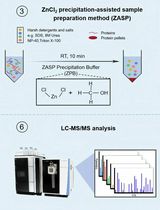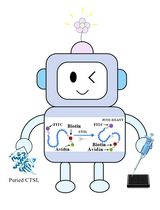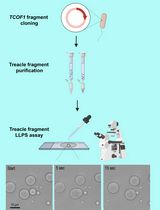- EN - English
- CN - 中文
Isolation of Chromatin-bound Proteins from Subcellular Fractions for Biochemical Analysis
从亚细胞成分中分离用于生化分析的染色质结合蛋白
发布: 2018年10月05日第8卷第19期 DOI: 10.21769/BioProtoc.3035 浏览次数: 20228
评审: Pabitra Kumar SahooAnna La TorreAnonymous reviewer(s)
Abstract
Shuttling of proteins between different cellular compartments controls their proteostasis and can contribute in some cases to regulate their activity. Biochemical analysis of chromatin-bound proteins, such as transcription factors, is often difficult because of their low yield and due to the interference from nucleic acids. This protocol describes a method to efficiently fractionate cells combined with a mechanical (i.e., sonication) or an enzymatic treatment (i.e., benzonase) that facilitates analysis of chromatin-bound protein extracts by Western blot analysis or by protein pull-down assays. This approach can be valuable to enrich a particular protein within a particular subcellular fraction either to study specific post-translational modification patterns or to identify specific protein-protein interactions.
Keywords: Chromatin-bound proteins (染色质结合蛋白)Background
The activity and post-translational regulation of many chromatin-bound proteins are poorly studied due to technical difficulties in isolating them for biochemical analysis. This is, even more, the case with transcription factors, such as the basic Helix-loop-Helix (bHLH) transcription factors that often harbor scarce temporal and spatial pattern of expression in tissues or cellular models (Dennis et al., 2018). Protocol refinement helps to lift technical limitation when the amount of biological materials become a barrier to investigate molecular pathways (Gillotin and Guillemot, 2016). In our recent study, we endeavored to understand how proteolysis of the proneural bHLH transcription factor Ascl1 is regulated in cellular models of neuronal differentiation (Gillotin et al., 2018). For this, we adapted existing protocols for subcellular fractionation to obtain efficient separation of the cytoplasm, nuclear and chromatin fractions. To be able to perform biochemical analysis on the chromatin fraction, we either used sonication to shear nucleic acids or treated this fraction with benzonase to degrade nucleic acids. These steps were essential to perform Western blot analysis or protein pull-down assays (Figure 1). This approach successfully led to the analysis of Ascl1 ubiquitylation pattern in the cytoplasm and in the chromatin fractions (Gillotin et al., 2018) and can be extended to the study of other chromatin-bound proteins and to other post-translational modifications.
Figure 1. Workflow of the protocol. First, the collection of each subcellular fraction is performed by successive protein extractions with the buffer E1, then with the buffer E2 and with the buffer E3. Second, the chromatin fraction is either sonicated to shear the DNA or treated with benzonase to digest nucleic acids. Third, each fraction is biochemically analyzed for a protein of interest. The purity of each fraction should be controlled by Western blot for α-Tubulin, LaminB and Histone H3 depicting respectively the cytoplasmic fraction, the nuclear fraction and the chromatin fraction.
Materials and Reagents
Note: All stock solutions should be stored at room temperature except when indicated otherwise.
- Microcentrifuge tubes (Sigma-Aldrich, catalog number: Z336769 )
- 10 cm tissue culture dishes (Thermo Fisher Scientific, NuncTM, catalog number: 150350 )
- Cell scraper (TPP Techno Plastic Products, catalog number: 99002 )
- Pipette tips (STARLAB, TipOne® filter tips, catalog number: S1120 )
- Neural stem cells Cor3-1 (from Steve Pollard, University of Edinburgh)
- P19 cells (ATCC, catalog number: CRL-1825 )
- Protease cocktail inhibitor (Roche Diagnostics, catalog number: 04693116001 )
- 500 mM HEPES-KOH, pH 7.5 prepared from powder (Sigma-Aldrich, catalog number: H3375 )
- 0.5 mM EDTA, pH 8.0 (Sigma-Aldrich, catalog number: 93283 )
- 500 mM EGTA, pH 8.0 prepared from powder (Sigma-Aldrich, catalog number: E3889 )
- 5 M NaCl prepared from powder (Sigma-Aldrich, catalog number: S7653 )
- 1 M MgCl2 prepared from powder (Sigma-Aldrich, catalog number: M8266 )
- 1 M Tris-HCl, pH 8.0 prepared from powder (Sigma-Aldrich, catalog number: RDD008 )
- 1 M Tris-HCl, pH 7.5 prepared from powder (Sigma-Aldrich, catalog number: RDD008 )
- 1 M Tris-HCl, pH 6.8 prepared from powder (Sigma-Aldrich, catalog number: RDD008 )
- 50% Glycerol (Sigma-Aldrich, catalog number: G5516 ) diluted in deionized water
- 10% SDS (Sigma-Aldrich, catalog number: 71736 )
- 10% NP-40 (Sigma-Aldrich, catalog number: I8896 ) diluted in deionized water
- 10% Triton X-100 (Sigma-Aldrich, catalog number: T8787 ) diluted in deionized water
- 100 mM DTT prepared from powder (Sigma-Aldrich, catalog number: 43815 ), store at -20 °C
- PBS (Thermo Fisher Scientific, catalog number: 10010023 )
- Benzonase 10 ku (Merck, Novagen®, catalog number: 70664-3 )
- α-Tubulin antibody (Abcam, catalog number: ab7291 )
- LaminB (Santa Cruz Biotechnology, catalog number: sc-6216 or Gene Tex, catalog number: GTX103292 )
- Histone H3 (Abcam, catalog number: ab1791 )
- E1 Buffer (see Recipes)
- E2 Buffer (see Recipes)
- E3 Buffer (see Recipes)
- E3 (benzonase) Buffer (see Recipes)
Equipment
- Pipettes
- Nanodrop (e.g., Thermo Fisher Scientific, model: NanoDropTM 3300 )
- Water bath sonicator (e.g., Diagenode, model: Bioruptor® )
- Refrigerated centrifuge (e.g., Eppendorf, model: 5415 R )
- Rotating platform (e.g., Grant Instruments, 360° Vertical Multi-function Rotator)
Procedure
文章信息
版权信息
© 2018 The Authors; exclusive licensee Bio-protocol LLC.
如何引用
Gillotin, S. (2018). Isolation of Chromatin-bound Proteins from Subcellular Fractions for Biochemical Analysis. Bio-protocol 8(19): e3035. DOI: 10.21769/BioProtoc.3035.
分类
神经科学 > 细胞机理 > 蛋白质分离
干细胞 > 多能干细胞 > 基于细胞的分析方法
生物化学 > 蛋白质 > 分离和纯化
您对这篇实验方法有问题吗?
在此处发布您的问题,我们将邀请本文作者来回答。同时,我们会将您的问题发布到Bio-protocol Exchange,以便寻求社区成员的帮助。
Share
Bluesky
X
Copy link













